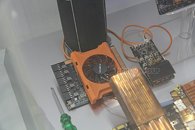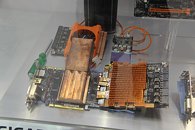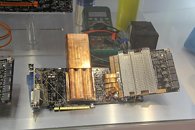Monday, June 2nd 2014

Gigabyte Unveils SuperOverclock VRM Boards for Graphics Cards
Gigabyte showed us its new range of auxiliary VRM boards for graphics cards, designed for professional overclockers. The board has to be manually soldered onto your graphics card, it supplements your card's GPU power domains. The card features a high-current power stage, which draws power from five 8-pin PCIe power connectors. The power stage is actively cooled by a fan-heatsink. While your GPU may never need that much power, it makes near darn sure that it doesn't suffer from voltage droop, which destabilizes your record-seeking OC. Such devices have been attempted by other VGA makers in the past, famously, the EPower Board by EVGA. The company also showed off its first liquid-nitrogen evaporators for GPUs.



6 Comments on Gigabyte Unveils SuperOverclock VRM Boards for Graphics Cards
I wonder where I could buy one of these.
Reference cards like 780, 780 ti, Titan, Titan Black, 290x, etc. have bad vrms, so that way you get higher clocks with voltage above 1.4-1.5v.
Just for comparison the R9 290X uses 150nH chokes across five phases when most other high end cards use 220nH chokes on six phases or more phases. The HD 7970 used 220nH 60A chokes on 6 phases and some HD7970 records are still held by the reference cards even after the MATRIX and Lightning came out. So really if AMD had just used bigger chokes the R9 290X VRM would have been OK. I even found chokes that have lower electrical resistance push the same current and have higher inductance but their just too big compared to the reference R9 290X chokes and would have required a longer or wider PCB.
Now to support your point of view, yeah AMD's VRMs are better because many Titan, 780 Ti and cards with similar PCB have died with voltage <1.5 and in some cases with lower than 1.4 V as well. I never saw a card dying by inductors but mostly cause of cheap/no hi-end mosfets and thats because IC, handles (values and everything) the Vdroop and voltages but mosfets do the real job, thats why mosfets get hot.
Last but not least, you couldnt make a 290x work with Evga Epower because you had to surpass the ΙΩR IC. That IC cuts the rest voltages of the card (I dont know if all or just VCCIO) in case you solder epower. GB did a nice trick to avoid that but I cant get into any more details because I dont know if they want me to. :P
Also drawing too much current through an inductor causes it's inductance to drop massively causing v ripple t get so big that whatever it's feeding will error the good news is that a reboot is eenough to fix that most of the time.
Sorry for spelling I'm on a phone